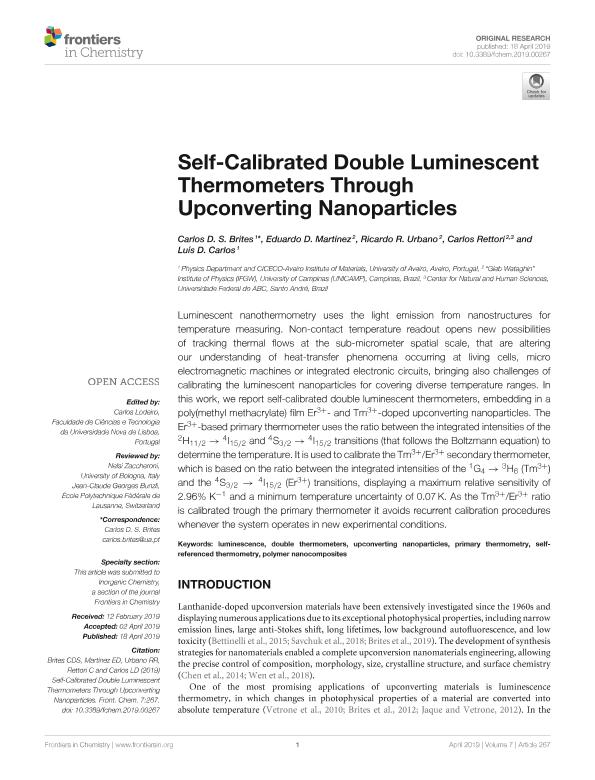Mostrar el registro sencillo del ítem
dc.contributor.author
Brites, Carlos D.S.
dc.contributor.author
Martínez, Eduardo David

dc.contributor.author
Urbano, Ricardo R.
dc.contributor.author
Rettori, Carlos
dc.contributor.author
Carlos, Luís D.

dc.date.available
2021-01-26T14:44:46Z
dc.date.issued
2019-04
dc.identifier.citation
Brites, Carlos D.S.; Martínez, Eduardo David; Urbano, Ricardo R.; Rettori, Carlos; Carlos, Luís D.; Self-calibrated double luminescent thermometers through upconverting nanoparticles; Frontiers Media S.A.; Frontiers in Chemistry; 7; APR; 4-2019; 1-10
dc.identifier.issn
2296-2646
dc.identifier.uri
http://hdl.handle.net/11336/123737
dc.description.abstract
Luminescent nanothermometry uses the light emission from nanostructures for temperature measuring. Non-contact temperature readout opens new possibilities of tracking thermal flows at the sub-micrometer spatial scale, that are altering our understanding of heat-transfer phenomena occurring at living cells, micro electromagnetic machines or integrated electronic circuits, bringing also challenges of calibrating the luminescent nanoparticles for covering diverse temperature ranges. In this work, we report self-calibrated double luminescent thermometers, embedding in a poly(methyl methacrylate) film Er 3+ - and Tm 3+ -doped upconverting nanoparticles. The Er 3+ -based primary thermometer uses the ratio between the integrated intensities of the 2 H 11 /2→4I 15/2 and 4 S 3 /2→4I 15/2 transitions (that follows the Boltzmann equation) to determine the temperature. It is used to calibrate the Tm 3+ /Er 3+ secondary thermometer, which is based on the ratio between the integrated intensities of the 1 G4→3H 6 (Tm 3+ ) and the 4 S 3 /2→4I 15/2 (Er 3+ ) transitions, displaying a maximum relative sensitivity of 2.96% K -1 and a minimum temperature uncertainty of 0.07 K. As the Tm 3+ /Er 3+ ratio is calibrated trough the primary thermometer it avoids recurrent calibration procedures whenever the system operates in new experimental conditions.
dc.format
application/pdf
dc.language.iso
eng
dc.publisher
Frontiers Media S.A.

dc.rights
info:eu-repo/semantics/openAccess
dc.rights.uri
https://creativecommons.org/licenses/by/2.5/ar/
dc.subject
DOUBLE THERMOMETERS
dc.subject
LUMINESCENCE
dc.subject
POLYMER NANOCOMPOSITES
dc.subject
PRIMARY THERMOMETRY
dc.subject
SELF-REFERENCED THERMOMETRY
dc.subject
UPCONVERTING NANOPARTICLES
dc.subject.classification
Nano-materiales

dc.subject.classification
Nanotecnología

dc.subject.classification
INGENIERÍAS Y TECNOLOGÍAS

dc.title
Self-calibrated double luminescent thermometers through upconverting nanoparticles
dc.type
info:eu-repo/semantics/article
dc.type
info:ar-repo/semantics/artículo
dc.type
info:eu-repo/semantics/publishedVersion
dc.date.updated
2020-12-23T21:02:42Z
dc.journal.volume
7
dc.journal.number
APR
dc.journal.pagination
1-10
dc.journal.pais
Alemania

dc.description.fil
Fil: Brites, Carlos D.S.. Universidade de Aveiro; Portugal
dc.description.fil
Fil: Martínez, Eduardo David. Universidade Estadual de Campinas; Brasil. Consejo Nacional de Investigaciones Científicas y Técnicas. Oficina de Coordinación Administrativa Ciudad Universitaria. Unidad Ejecutora Instituto de Nanociencia y Nanotecnología. Unidad Ejecutora Instituto de Nanociencia y Nanotecnología - Nodo Bariloche | Comisión Nacional de Energía Atómica. Unidad Ejecutora Instituto de Nanociencia y Nanotecnología. Unidad Ejecutora Instituto de Nanociencia y Nanotecnología - Nodo Bariloche; Argentina
dc.description.fil
Fil: Urbano, Ricardo R.. Universidade Estadual de Campinas; Brasil
dc.description.fil
Fil: Rettori, Carlos. Universidade Estadual de Campinas; Brasil
dc.description.fil
Fil: Carlos, Luís D.. Universidade de Aveiro; Portugal
dc.journal.title
Frontiers in Chemistry
dc.relation.alternativeid
info:eu-repo/semantics/altIdentifier/doi/http://dx.doi.org/10.3389/fchem.2019.00267
dc.relation.alternativeid
info:eu-repo/semantics/altIdentifier/url/https://www.frontiersin.org/articles/10.3389/fchem.2019.00267/full
Archivos asociados
